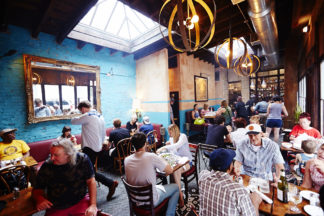Over the past few weeks we’ve used this space to talk about how food businesses in
Brooklyn have managed to lessen their environmental impact by composting waste and getting meat from good farms. Before they can get to all that, they need to have actual restaurants and stores in which to serve us. That happens to be the first place these businesses (and their architects or designers) can make good choices for the environment.
When you picture a restaurant that’s furnished and built with reused materials, you may imagine something like Bed-Stuy’s Chez Oskar, and that’s the way owner Charlotta Janssen likes it. 
“For me, if you are in the restaurant and take a picture or just meet someone, you want to be on a background that has character, not just, ‘Oh, the chair is catalog number this and the lamp is catalog number that,’ ” Janssen, who is also a visual artist, told Taste Talks.
To create that character when the restaurant moved from its home of 18 years in Fort Greene last year, Janssen enlisted the help of her architect Eva Marie Lansberry and builder James Davis, along with general manager Angelique Calmet Strakker and chef Octavio Simancas. They brought along several elements from their old restaurant, including two Venezuelan apothecary cases that had been turned into bar backs.
Then she made sure her new elements weren’t new. Their old bar wouldn’t fit, so they used reclaimed two-by-fours from a neighbor and old doors. Wine barrel rings became modern spherical chandeliers. Then she hit up two of her favorite places to “pick,” BIG Reuse in Brooklyn and Queens. Amid the giant warehouses full of used furniture, fixtures, appliances, and building materials, she found some treasures: three red banquets that “emanated Chez Oskar,” old desk lamps to turn into wall and ceiling fixtures, and a giant carved doorway.
“The doorway was hell,” she admitted. But also totally worth the struggle, once they got it to fit in the space as the pass-through between the kitchen and dining space. “I think it is good to work with pieces that have a history, and that is also on the right side of recycling and on the right side of your budget. They work hand in hand.”
History is also something sustainable design company Tri-Lox values, albeit with an entirely different aesthetic.
“You place more value on the things you know the story of,” co-founder Ellis Isenberg told Taste Talks.
The Greenpoint-based firm turns high-quality reclaimed wood into sleek, modern-looking products in restaurants such as Berg’n, Sons of Thunder, and Shake Shack (in addition to a lot of places that have nothing to do with food).
“One thing that we really try to do is show that just because something is recycled or is a reclaimed product doesn’t mean that it has to be super rustic,” he said.
Tri-Lox works with demolition companies, small sawmills in the Northeast, and the occasional farmer to acquire high quality wood from old water towers, barns, and industrial buildings. Then they “re-manufacture” the wood by sawing, kiln-drying, and finishing it. This means fewer trees being cut down, and less material going into the waste stream.
“At this point, there’s enough companies doing this type of work that it’s not like it otherwise would be thrown away,” Isenberg acknowledges of the materials they use. He likes to think of their approach as an offshoot of the farm-to-table concept in the way that they work with small businesses to encourage more environmentally friendly practices. To that end the company also works with local sustainable foresters for newly harvested wood, as well.
Tri-Lox’s latest products will soon be seen in a new Shake Shack on Astor Place, and the Grimm Artisanal Ales brewery and Tap Room that’s coming to Williamsburg.
Though it may seem like a single restaurant’s design choices wouldn’t affect environment one way or the other, it adds up.
“If a developer [of a building] chooses to work with a reclaimed product or a sustainably harvested product, that choice might save a whole forest of trees,” Isenberg said. “Architects and designers’ choices have a really big impact.”











